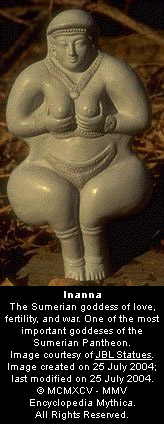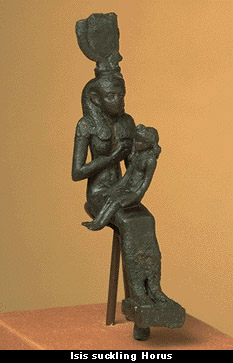

By the time history began between five or six thousands year ago, with the appearance of the first writing, a change had already taken place and in most known civilizations a supreme male deity had taken the place of the supreme female one. Society as we know it from those days was ruled by males; women were delegated not just to second place but in many cases had become subservient to their male folks. Every woman had to listen and obey her father, her brothers, her husband and even her sons, with very little voice of her own. A reflection of this social structure can be clearly seen in the Mesopotamian story of Gilgamesh, where the great goddess Ishtar, formerly, in the figure of Inanna, the Queen of Heaven, Mother of Gods and Ruler of all the world, is subject to her new father, the Sky god Anu (notice the similarity to the name of Inanna). A remnant to the older religion can be seen in the reverence of such patriarchal society for ancient Mother figures who no longer have any real power.
 As to polytheism, it could have stemmed from the joining together of the faiths and rituals of different tribes to one tribal group, as each one of them brings to the group its own separate divinities; each tribe with its own Mother goddess and her Son, the leader of the tribe, joining them into one hierarchical system. The collection of the twelve tribes of Israel into one people is an example in case. Although they all considered themselves sons of one father, their mothers were different, and there is an assumption that in ancient times, those mothers had each the standing of a Mother goddess; but the greatest Mother goddess of Israel was named Sarah, which means "ruler". The overall Mother of the World, though, mentioned in the Old Testament, is Hava (Eve), whose name is interpreted even in the patriarchal Bible as "Mother of all Living". Here are the names of some such ancient goddess, most of them are considered overall mothers or creators of the world. By the time of the beginning of history they had lost their power to male divinities, though people have not yet forgotten their names: Inanna/Ishtar of Mesopotamia; Tiamat of Babylon; Hathor/Isis of Egypt; Gaia of Greece; Cybele of Anatolia, Shakti of India, the Chinese Queen Mother of the West, the Navaho Changing Woman and many others. While according to old myths these goddesses were very powerful in their time in all areas of rule, the main female divinities known today are concerned with nothing but mercy and compassion, as are the Far Eastern Quan Yin, the Catholic Mary Mother of Jesus, and the Jewish Shekhinna, who is the feminine side of God.
As to polytheism, it could have stemmed from the joining together of the faiths and rituals of different tribes to one tribal group, as each one of them brings to the group its own separate divinities; each tribe with its own Mother goddess and her Son, the leader of the tribe, joining them into one hierarchical system. The collection of the twelve tribes of Israel into one people is an example in case. Although they all considered themselves sons of one father, their mothers were different, and there is an assumption that in ancient times, those mothers had each the standing of a Mother goddess; but the greatest Mother goddess of Israel was named Sarah, which means "ruler". The overall Mother of the World, though, mentioned in the Old Testament, is Hava (Eve), whose name is interpreted even in the patriarchal Bible as "Mother of all Living". Here are the names of some such ancient goddess, most of them are considered overall mothers or creators of the world. By the time of the beginning of history they had lost their power to male divinities, though people have not yet forgotten their names: Inanna/Ishtar of Mesopotamia; Tiamat of Babylon; Hathor/Isis of Egypt; Gaia of Greece; Cybele of Anatolia, Shakti of India, the Chinese Queen Mother of the West, the Navaho Changing Woman and many others. While according to old myths these goddesses were very powerful in their time in all areas of rule, the main female divinities known today are concerned with nothing but mercy and compassion, as are the Far Eastern Quan Yin, the Catholic Mary Mother of Jesus, and the Jewish Shekhinna, who is the feminine side of God.
 The masculine monotheism, which had put Man above all animals, stems from the Jewish hierarchic principle of the Old Testament which says, "You have made him little less than God"; in this way Man was also put above Woman. The religious story of Genesis, which tells how the woman was made up from the man's rib, makes it impossible for any woman in society to be equal to any man, and this attitude is still continuing to day in societies that have assumed the masculine monotheistic systems. But although her social standing is low, her power to affect Man, his life and behavior, still exists and widely recognized in two area: in her being a mother, and through her sexual attraction. It is, however, usual to think much less of women's mental power, assuming them to be not much more adult than grown children, and that is how they should be treated.
The masculine monotheism, which had put Man above all animals, stems from the Jewish hierarchic principle of the Old Testament which says, "You have made him little less than God"; in this way Man was also put above Woman. The religious story of Genesis, which tells how the woman was made up from the man's rib, makes it impossible for any woman in society to be equal to any man, and this attitude is still continuing to day in societies that have assumed the masculine monotheistic systems. But although her social standing is low, her power to affect Man, his life and behavior, still exists and widely recognized in two area: in her being a mother, and through her sexual attraction. It is, however, usual to think much less of women's mental power, assuming them to be not much more adult than grown children, and that is how they should be treated.






















